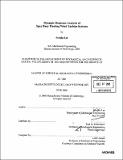Dynamic response analysis of spar buoy floating wind turbine systems
Author(s)
Lee, Sungho, Ph. D. Massachusetts Institute of Technology
DownloadFull printable version (49.74Mb)
Other Contributors
Massachusetts Institute of Technology. Dept. of Mechanical Engineering.
Advisor
Paul D. Sclavounos.
Terms of use
Metadata
Show full item recordAbstract
The importance of alternative energy development has been dramatically increased by the dwindling supplies of oil and gas, and our growing efforts to protect our environment. A variety of meaningful steps have been taken in order to come up with cleaner, healthier and more affordable energy alternatives. Wind energy is one of the most reliable energy alternatives for countries that have sufficiently large wind sources. Due to the presence of steady and strong winds, and the distance from coastline residential, the offshore wind farm has become highly attractive as an ideal energy crisis solution. Floating wind turbine systems are being considered as a key solution to make the offshore wind farm feasible from an economic viewpoint, and viable as an energy resource. This paper presents the design of a synthetic mooring system for spar buoy floating wind turbines functioning in shallow water depths. Nacelle acceleration, static and dynamic tensions on catenaries, the maximum tension acting on the anchors are considered as design performances, and a stochastic analysis method has been used to evaluate those quantities based on sea state spectral density functions. The performance at a 100-year hurricane condition is being defined as a limiting case, and a linear wave theory has been the most fundamental theory applied for the present analysis.
Description
Thesis (S.M.)--Massachusetts Institute of Technology, Dept. of Mechanical Engineering, 2008. Includes bibliographical references (leaves 83-84).
Date issued
2008Department
Massachusetts Institute of Technology. Department of Mechanical EngineeringPublisher
Massachusetts Institute of Technology
Keywords
Mechanical Engineering.